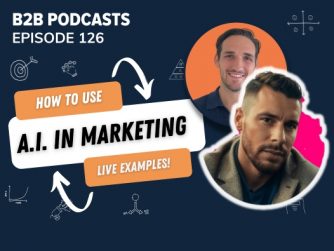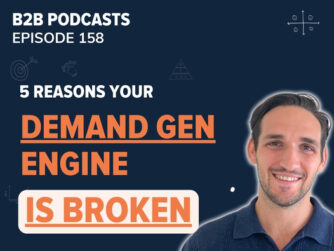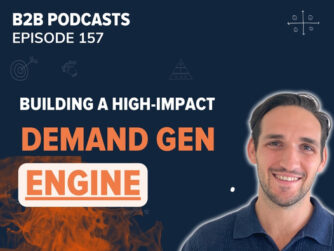Too often marketers ignore the power of ranking for their high-intent, ‘money’ B2B keywords. It gets put in the ‘too hard’ basket, thinking you need a stronger brand and domain authority before it can start to bring you a return.
Well, that’s exactly what we’re tackling today in a bit of an experiment. We’ve brought in the SEO heavy hitter Sam Dunning from Breaking B2B, and together we’re rolling up our sleeves to figure out how to rank our own money keywords in Google fast.

Here’s the deal: I want to show you, in real time, the exact steps we’re taking to get our demand generation course ranking on Google. Sam’s here to guide us through the process, but we’re not just talking about theory. This is about action, testing, and results. If we can pull this off, you’ll be able to take these exact same steps and apply them to your B2B business.
Stick around, because we’ll be unpacking keyword strategies, on-page SEO, and how to build backlinks that actually move the needle. We’re documenting this journey step by step, so you can see what works and what doesn’t as we go.
Make sure you subscribe to our newsletter to follow along and see the results!
This is more than just SEO talk—this is about getting real results. Let’s get started!
Listen To The Episode
Watch The Episode
Why Are We Listening To Sam Dunning?
If you want proof that Sam Dunning knows what he’s talking about, just look at his own results. In 90 days, Sam managed to rank his website Breaking B2B for the highly competitive keyword “B2B SEO agency.” And keep in mind, this was no small feat – he was up against competitors who had been in the SEO game for decades. Sam’s strategy didn’t rely on brute-force tactics like spamming backlinks or technical SEO overload. Instead, he focused on what he calls “customer insights, transparency, and hands-on experience,” which gave him the edge to win in a competitive market.

He took a brand-new site with zero domain authority and, by month two, had already climbed to positions 10-12 in search results. Then, with the right tweaks to content and a few strategic backlinks, he hit position one for his money keyword in both the US and the UK by month three.
Pretty damn awesome. So now he’s going to show us how we can do it for ourselves and rank for our money keywords:
- ‘Demand generation course’, and
- ‘Demand generation training’
We’re taking his strategy, executing on it and reporting back so you can see how it goes!

Follow along so you can steal the strategy too.
Step 1 – Choose the Right Money Keywords
When it comes to SEO, one of the biggest mistakes we can make is going too broad with our keyword choices. You see a bigger search term like “B2B marketing course” and think, “Great! If I rank for this, I’ll get loads of traffic.” But the reality? That traffic is often too scattered and too competitive to convert into meaningful pipeline.
Sam put it perfectly when he said,
“B2B marketing is much broader and harder to rank for… Demand generation is more niche and specific to what you’re offering”
Sam Dunning – The B2B Playbook
Instead of chasing high-traffic terms, you need to think about what Sam calls your “money keywords”—those niche terms that show real intent from the searcher. In our case, we decided to focus on “demand generation course” and “demand generation training.” Why? Because, as Sam pointed out, “someone’s probably not searching ‘demand generation course’ for fun. They’re looking for help”

It’s all about targeting keywords that speak directly to the pain points of your audience. These are the people actively seeking a solution, not just window-shopping.
For us these keywords perfectly aligned with our niche (serving Demand Generation Marketers) and were high-intent (aligned with our offering).
Step 2 – Analyse Competitors Thoroughly
You can’t build a winning SEO strategy without knowing who you’re up against—and Sam hammered this point home in our conversation. When he looked at the top two results for “demand generation course,” he found Cognism and CXL sitting comfortably at the top. But here’s the thing: CXL’s page hadn’t been updated in a while, and even better, their course was archived.
Sam’s reaction? “That’s a gap we can exploit”

The lesson here is that even the biggest players have weaknesses. While Cognism has invested heavily in SEO with a strong domain authority of 75 and 30,000 backlinks, CXL’s outdated content offered an opportunity for us to swoop in.
So the good news B2B marketers is that it’s not just about outgunning them in terms of authority. Sometimes, the real wins come from adding more value or fresher content than what’s currently ranking. Sam shared that when it came to ranking for his own money keyword ‘B2B SEO Agency”: “We leveraged customer insights and transparency—things other agencies are scared to share on their pages. That’s what helped us stand out”
By identifying what your competitors are missing and doing it better, you can leapfrog even the most well-established sites.
Step 3 – Build a High-Authority, Long-Form Page
If you want to rank in SEO, creating content that’s deep, insightful, and full of value is essential. People love this, which means Google love it – and that means going long-form. Sam’s whole approach was about building a solution page that leaves no question unanswered. As he said referencing his own website, “The page that’s ranking for me is a solution page… with long-form content and unique insights” It’s not just about length, though; it’s about covering every angle of the user’s intent.
Now, let’s talk about our current page. Sam reviewed it and had some solid insights. First off, he noticed that we’ve already done some things right. For instance, we’re hitting about 4,400 words, which is a great start compared to competitors like CXL, whose page was just under 3,000 words. Sam felt that we should try and beat our competitors in terms of word count.

However, there are some areas we can tighten up. Sam pointed out that while our current page is customer-centric, it’s not particularly Google-friendly. We need to tweak the structure, especially when it comes to optimizing the URL and metadata for keywords like “demand generation course.” “We ideally want our main focus keyword within that URL itself. So that might be demand-generation-training or demand-generation-course”.

But what really makes a difference? Unique insights. Sam stressed that “We leveraged customer insights, transparency, and hands-on experience… things other agencies were traditionally scared to share” (03:30)(YT – Sam Dunning SEO Co…). If we add that level of detail and openness to our content—giving away more than the competition—we’ll build a page that Google loves and one that customers trust. It’s all about creating the most comprehensive and transparent resource on the topic.
To sum it up: we’ve got a strong foundation, but by weaving in more unique insights and tightening up our SEO structure, we can take our page to the next level and make it the go-to resource for demand generation in B2B.
Step 4 – Optimize On-Page Elements
When it comes to on-page SEO, the basics matter more than you think. Meta titles, descriptions, heading tags, and URLs—these are things that can make or break your ability to rank for your money keywords. Sam was crystal clear about this: “We want to rank for it, but at the same time, we want to make sure it’s juicy enough that folks actually click it”.
That’s the balance we need to strike. Your meta title should include your target keyword, but it also needs to hook your audience. For example, if you’re targeting “demand generation course,” why not spice it up with something like ‘Demand Generation Course (Hit Your SQL Targets in 2024)’? That little addition could make all the difference.
Meta descriptions are another area where you can drive clicks. As Sam pointed out,
“Make sure the meta description includes your keyword along with something short and snappy that highlights the problems you fix and the outcome you provide”.
Sam Dunning – The B2B Playbook
It’s not just about cramming in keywords; it’s about telling the user why they should care.
Next, we can’t overlook heading tags. Sam’s advice here was super practical: “You should only have one H1 per page. Ideally, it would say something like ‘demand generation course’ or ‘demand generation training’”.
The H1 tells Google and the reader exactly what your page is about. For the subheadings (H2, H3, etc.), weave in your keywords naturally. No need to overdo it—Google can smell keyword stuffing a mile away.
Lastly, let’s talk URLs. It’s something simple that a lot of people overlook, but Sam advised us to make sure our URL includes demand-generation-course or demand-generation-training. Keeping the URL clean, concise, and keyword-rich gives Google a clear signal of what your page is about, and it makes it easier for users to understand at a glance.
Step 5 – Create a Content Structure That Converts
The key to a high-converting page is addressing your audience’s pain points right out of the gate. Sam was clear on this: “Struggling to drive leads and revenue—calling that out in the beginning is smart. It agitates the problem and keeps them reading”. If you’re not hitting on the issues your audience cares about right away, you’ve already lost them. They need to feel like you understand their challenges before they’ll trust that you have the solution.

Once you’ve got them hooked, it’s time to show them what life could look like on the other side. As Sam pointed out, we do this well by bridging the gap between their current struggles and the success they want to achieve: “Your job isn’t to get more leads; it’s to drive more revenue”. This shift in focus helps keep our Ideal Customers engaged because now they’re thinking about outcomes that matter to them—more revenue, more impact, more growth.

From there, it’s all about keeping them interested with smart content placement.
As Sam said, “You’ve got regular calls to action and social proof throughout the page, which is what I’d recommend for a long-form solution-based page”
The more you can guide your Dream Customers toward taking action—whether it’s booking a call or downloading a guide—the closer they get to converting. And it you should absolutely sprinkle in some testimonials and success stories along the way. As people scroll, through our landing page, they see happy clients, reviews, and the fact that they’ll get a Certificate of Demand Generation—all of which build trust.


Finally, reinforcing these benefits with a clear structure—like a strong headline and engaging hero section—can make all the difference. Sam emphasized the importance of a bold headline that hits hard: “We want something strong in the H1, like ‘Demand Generation Course: Build Your Demand Gen Engine in 12 Weeks.’ That’s something your audience will connect with”.
Combine that with an embedded video, which Google tends to favour (according to Sam) and you’ve got a page that keeps people engaged and pushes them to act,
By addressing pain points early, guiding the reader through their journey, and using engaging elements like CTAs and testimonials, you create a page that not only ranks but has a better chance of getting that person to take the action you want.
Step 6 –
If there’s one thing that turns visitors into buyers, it’s trust. And there’s no better way to build that trust than with social proof. Sam was clear on this: “You’ve got regular calls to action and social proof throughout the page, which is what I’d recommend for a long-form solution-based page”.
Testimonials, reviews, and case studies are essential—they show people that your solution works and that others have already benefited from it.
We make a point of showcasing happy clients and successful stories from marketers who have been through The B2B Incubator. These testimonials are strategically placed to keep readers engaged as they scroll. Whether it’s a quote from a satisfied customer or a case study of how a marketer grew their pipeline, this social proof is what builds credibility.
Sam also liked that we used a FAQs section to overcome objections and build trust. By addressing questions like “What will I learn?” or “Who is this course for?”, you not only resolve doubts but also create an opportunity to reinforce key selling points.

His advice to us on these was to weave target keywords into these answers boosts SEO: “If we can weave in any FAQs around demand generation course pricing, how it works, what’s involved… It’s making sure we’re showing Google that we’re talking about the subject at hand”.
Step 7 – Refine Technical SEO for Better Rankings
It’s not just about content; technical SEO is where the magic happens for better rankings. Sam stressed this when we discussed how critical it is to get your meta titles, descriptions, and headers right. As he put it, “We want this to have a nice click-through rate… Perhaps demand generation course or demand generation training within that title”. It’s not enough to just rank—you need to make sure people are clicking through. That’s where a well-crafted meta title comes in, and the bonus? It’s a powerful ranking signal for Google.
Sam’s advice on meta descriptions was golden: “I sometimes like to sneak in titles like ‘Hit your SQL targets for 2024’… It makes it juicy enough for folks to actually click through”. Your meta description needs to do more than just stuff in keywords. It has to tell people why they should care. And when you make it clear what results they’ll get—whether it’s more revenue or hitting those 2024 SQL targets—you’re giving them a reason to click.
And don’t forget about the basics: “We need our main keyword, like demand generation course, within the H1… also, make sure it’s in the URL. This signals Google what the page is about”. He also advised us to work “demand generation course” and “demand generation training” naturally throughout the page.
When you structure your headings and URLs with the right keywords, you’re helping both Google and your audience know exactly what they’ll get.
Step 8 – Leverage Internal Linking
Internal linking might not seem flashy, but it’s a great way to make sure your page is easily discovered and crawled by Google. By linking relevant content from other parts of your site, you’re guiding Google through your pages and signalling which ones are most important.
What’s key here is to be strategic. It’s not about throwing links everywhere—it’s about weaving your target keywords into the internal links. Sam recommended that we find existing relevant pages on The B2B Playbook website, and put the keyword ‘demand generation course’ in there and link out to the page we were trying to rank.
Step 9 – Build High-Quality Backlinks
Backlinks are still essential to help your page rank on Google. But getting backlinks doesn’t have to be overwhelming. In fact, you can leverage the connections you already have.
Sam advised me to reach out to podcasts that I’ve appeared on, and ask them to link to my new webpage. If you’ve already been featured on a podcast or collaborated with partners, those relationships are a goldmine for backlinks. Just reach out and ask for a link back to your page you’re trying to rank.
Likewise if any of your internal Subject Matter Experts have done the same, or joined a webinar with a partner – you can use the same strategy.
Another effective tactic is guest posting. Sam shared how he reached out to SaaS companies offering valuable content in exchange for a do-follow backlink: “I reviewed their website, reached out to a bunch of SaaS companies, and said, look, I’m up for doing a guest article… I do need a do-follow backlink to this page for this target keyword”. It’s a win-win—you provide great content, and in return, you get a valuable backlink to your site.
The good news? You don’t need hundreds of backlinks to see results. As Sam said, “You probably won’t need that many backlinks… We probably, from my experience, only need four or five”. For a lower-competition keyword like “demand generation course,” just a few high-quality links from trusted sources can make all the difference.
Step 10 – Monitor and Optimize Over Time
Sam said that even with this strategy, SEO isn’t a “set it and forget it” game. It’s about constant monitoring and optimization. Once the page is live, the work isn’t done. In fact, it’s just getting started. You need to keep an eye on how it’s performing, how users are interacting with it, and where it’s ranking in Google.
After Google has had time to digest your content, that’s when you step in to make tweaks. It could be as simple as adding a few internal links, refreshing a headline, or tweaking a meta description to improve click-through rates. The point is, you need to be ready to adjust based on real data.
Follow Along!
So with Sam’s advice, off I went to execute. Tune in next week to see the results!
If you also want to execute on Sam’s advice, here are the key takeaways:
- Choose Specific, Intent-Driven Keywords
- Analyze Competitors and Identify Gaps
- Build a High-Authority, Long-Form Page
- Optimize On-Page Elements
- Leverage Internal Linking
- Build High-Quality Backlinks
- Monitor and Optimize Over Time
- Use FAQs to Overcome Objections and Build Trust
Check out the updated page we created based on Sam’s advice here.








